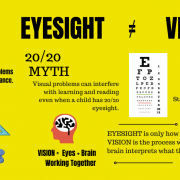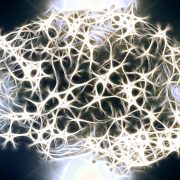Learning-related Vision Problem, Dyslexia, or ADD/ADHD?
Many of the observable traits that a child with ADD/ADHD and Dyslexia display are also seen in children with learning-related vision problems. A learning-related vision problem is a functional visual problem that interferes with a child’s ability to effectively process and interpret information seen through the eyes.
To understand how vision and learning are related, it’s necessary to know the difference between eyesight and vision. Eyesight and vision are two very distinct things. Eyesight is the ability to see letters clearly on a chart at a distance of 20 feet. A common misconception is that 20/20 eyesight means you have perfect vision. However, 20/20 eyesight is not enough. Vision is more than seeing clearly; it’s the ability to obtain meaning and understanding from what we see with our eyes. Vision is a complex combination of learned skills, including eye movement coordination, binocular fusion (eye teaming), accommodation (focus) and visualization. When visual skills are well developed, a person can sustain attention, read and write without careless errors, give meaning to what they see and rely less on movement to stay alert. When there is a vision problem, the visual system interferes and causes a mismatch between sensory information. The visual system then has difficulty integrating and communicating with other sensory systems resulting in a loss of information processing.
Research shows vision is learned, just as walking and talking are learned. A baby starts with the ability to receive light, but he/she must learn to interpret the incoming light into meaningful images. He must be able to: use both eyes together and point them in different directions (eye teaming); learn to follow a moving object with his eyes (eye tracking); learn to focus from near to far; and learn to coordinate his hands with eyes. All these skills are necessary for optimal performance in school.
Research has shown children with learning-related vision problems showed a 3x greater likelihood of ADHD. The diagnosis of ADD/ADHD should not be made lightly and because of the strong similarities with vision problems its important that a visual issue be ruled out prior to the diagnosis. Too often doctors are carelessly hurrying to a diagnosis of ADD/ADHD and prescribing dangerous drugs to children.
Dyslexia-type symptoms can be seen in children with deficits in visual skills like eye tracking, eye teaming and visual perceptual issues. These visual issues cause letters, numbers and words to appear to move or jump around on a page which leads to trouble with reversals.
The important question to ask is what is the child doing when the symptoms are displayed. Often times it’s most evident when the child is at school and is asked to sit and work at his desk. Current school settings require children to perform their duties seated and within a working distance of less than 16 inches. So if the majority of a child’s day at school is spent using their eyes with desk work, how much value should be placed on being able to see a letter chart at a distance of 20 feet. That is all that is performed during a school screening or at the pediatrician’s office. Does it make sense that the 20/20 test is going to provide enough information to determine if a child uses his/her eyes and visual system to effectively learn?
To determine if a visual issue is masquerading as a learning problem it’s necessary to have a functional vision evaluation with the appropriate near-point testing.





